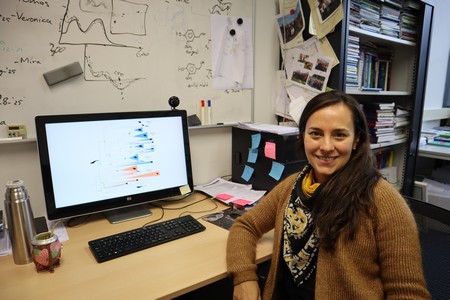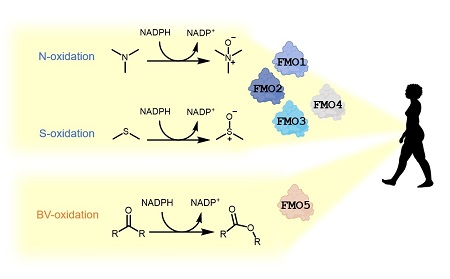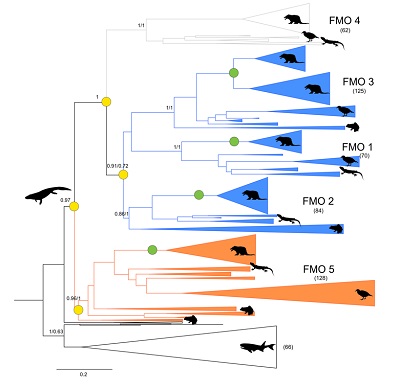Reconstructie van de evolutionaire geschiedenis van ontgiftende enzymen
Ons lichaam produceert allerlei enzymen die giftige stoffen afbreken. Een klasse daarvan zijn de flavine-bevattende monooxygenasen (FMO’s), die aanwezig zijn bij alle Tetrapoda (viervoeters). Mensen hebben vijf verschillende genen voor FMO enzymen, waarvan de eerste vier dezelfde activiteit vertonen. Maar het vijfde FMO enzym zorgt voor een heel andere afbraakreactie. Biochemici van de RUG hebben het voorouderlijke gen van alle FMO genen bij viervoeters gereconstrueerd en laten daarmee zien hoe die verschillende activiteiten zijn ontstaan. Hun onderzoek is op 24 februari gepubliceerd in Nature Communications.
FMO’s vind je in alle vormen van leven, van bacteriën tot planten en dieren. In mensen kunnen de FMO enzymen een groot aantal giftige stoffen afbreken. Vier van de vijf FMO genen bij mensen, die bovendien ook bij alle viervoeter voorkomen, zorgen voor de oxidatie van specifieke delen van gifstoffen (zogeheten heteroatomen) wat ze onschadelijk maakt. Maar FMO5 veroorzaakt een heel andere chemische reactie, dit enzym plaatst een zuurstofatoom tussen twee koolstofatomen in een keton of aldehyde groep.

Stamboom
‘Wij vroegen ons af waarom dit ene FMO gen een enzym produceert met een afwijkende activiteit’, zeg Laura Mascotti. Zij is gespecialiseerd in het reconstrueren van de evolutionaire geschiedenis van eiwitten en werkt als postdoc aan de RUG in de groep van enzym-ingenieur Marco Fraaije. Het verdubbelen van genen gebeurt regelmatig en de evolutietheorie verklaart waarom verschillende kopieën van een gen zich verschillend kunnen ontwikkelen. ‘Wij wilden weten of FMO5 een nieuwe eigenschap heeft gekregen, of dat het vooroudergen beide reacties kon uitvoeren en de verschillende FMO’s vervolgens een van beide zijn kwijtgeraakt.’
Naast wetenschappelijke nieuwsgierigheid – de groep van Fraaije reconstrueerde eerder de structuur van vier van de vijf voorouderlijke FMO genen in zoogdieren – kan dit onderzoek helpen om de werking van de enzymen aan te passen, of geneesmiddelen te ontwikkelen die zijn te activeren door de enzymen. Mascotti: ‘In dat eerdere werk hebben we de DNA sequenties voor FMO enzymen van alle levende organismen verzameld, en daarmee een evolutionaire stamboom gemaakt.’ Die liet zien dat FMO1 tot en met 4 nauw aan elkaar verwant zijn, terwijl FMO5 anders is. ‘Aangezien alle viervoeters deze vijf genen bezitten wisten we ruwweg wanneer het gemeenschappelijk vooroudergen in deze twee versies is opgesplitst.’

Onverwacht
Zij berekende de meest waarschijnlijke aminozuurvolgorde voor het gemeenschappelijke voorouder enzym van FMO1-4 en FMO5. ‘Dat deden we door te bepalen welk aminozuur het meest waarschijnlijk was voor elke positie in het eiwit’, legt Mascotti uit. ‘Het resultaat zal waarschijnlijk niet het echte originele gen zijn, maar wel met grote zekerheid de activiteit hebben van het oorspronkelijke enzym.’ Toen zij deze klus eenmaal geklaard had was de volgend stap het “tot leven wekken” van dit voorouderlijke enzym. ‘Daarvoor bestelden we de genen die deze aminozuurvolgorden zou produceren, en plaatsten dat in een standaard laboratoriumbacterie. Die produceerden vervolgens de enzymen, zodat we hun activiteit konden bepalen.
Deze voorouderlijke enzymen leverden verwachte en onverwachte resultaten op: ‘De voorouders van de beide enzym-typen lieten ruwweg dezelfde activiteit zien als de huidig enzymen. Maar de voorouder van alle vijf de FMO’s bleek allebei de reacties te kunnen uitvoeren’, vertelt Mascotti. Dit enzym kon heteroatomen oxideren én de ketonen en aldehyden. Dit wijst erop dat de moderne FMO genen een van beide activiteiten zijn kwijtgeraakt. Bovendien konden de onderzoekers laten zien dat een verschil van drie aminozuren in de enzymen het verschil in activiteit verklaarde.
‘Daarmee is de geschiedenis van deze enzymen vrij standaard’, concludeert Mascotti. ‘We denken dat het vooroudergen alle reacties kon uitvoeren. Dit gen is enkele malen gedupliceerd, waardoor de extra kopieën meer vrijheid hadden om te evolueren. Hierdoor ontstonden enzymen met de twee verschillende functies.’ Interessant is dat dit gebeurde in de periode waarin de viervoeters zich vanuit de oceanen ook op het land gingen vestigen. ‘Planten produceren veel gifstoffen, dus het was een voordeel voor dieren om die efficiënt te kunnen afbreken.’

Geneesmiddelen
De onderzoekers ontdekten ook dat de cofactor (een hulpstof) die de enzymen gebruiken belangrijk is voor het type reactie dat ze uitvoeren. ‘Aminozuren die geen deel zijn van het actieve centrum van de enzymen maar de cofactor binden, bleken van groot belang te zijn voor de functie. Doorgaans is een cofactor gewoon een elektronendonor, maar in dit geval bepalen ze de activiteit, wat nogal uniek is.’ Deze kennis over de relatie tussen de structuur en de functie van de enzymen is belangrijk voor de aanpassing van dit soort ontgiftende enzymen, of voor het ontwikkelen van remmers die de afbraak van geneesmiddelen vertragen.
Mascotti: ‘We hebben dankzij onze nieuwsgierigheid over de geschiedenis van deze enzymen nieuwe inzichten gekregen in hun manier van werken. Bijzonder is ook dat dit onderzoek alleen mogelijk was door de samenwerking binnen een zeer divers team, met specialisten op het terrein van enzymologie, evolutie en eiwitstructuren.’
Referentie: Gautier Bailleul, Guang Yang, Callum R. Nicoll, Andrea Mattevi, Marco W. Fraaije & Maria Laura Mascotti: Evolution of enzyme functionality in the flavin-containing monooxygenases. Nature Communications, 24 februari 2023
Meer nieuws
-
11 december 2025
Stormachtige planeten en een onverwachtse atmosfeer
-
09 december 2025
Faculty of Impact Grant voor nieuwe behandeling hersenkanker
